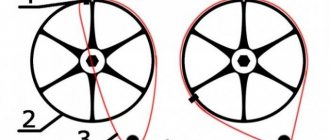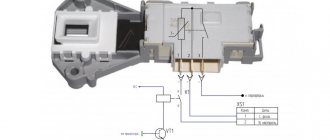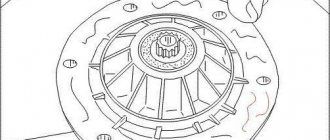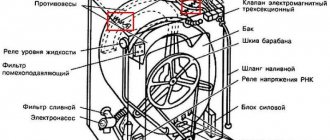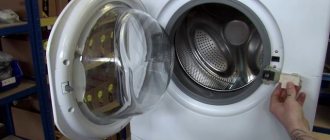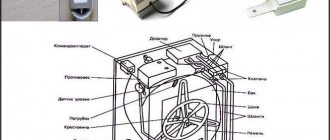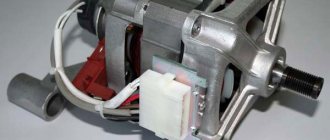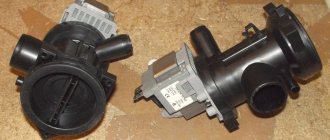How to identify the exact nature of the breakdown?
Washing equipment sometimes breaks down and becomes unusable for many reasons. If, during the washing and rinsing process, extraneous noise occurs, which is additionally accompanied by vibration, it can be assumed that the shock absorbers and parts of the part have crumbled or failed. However, the same symptoms can also be observed if the bearings in the washing machine have crumbled, or foreign objects have entered the space between the laundry tub and the body. To make sure that the shock absorbers are broken, you should first disconnect the washing machine from the network. After this, you need to open the doors to load laundry, then slightly pull the device towards you and release. If it falls into place without difficulty and extraneous noise, then the dampers are working. The washing machine swaying from side to side will be evidence that the springs have failed.
How to remove the part?
The hum and strong vibration of the washing machine during the washing process indicate that the shock absorbers need to be replaced.
You can dismantle a worn-out part by following a certain algorithm of actions:
- Disconnect the washing machine from the power supply, water supply and sewerage.
- Pull the washing machine away from the wall and place it on a flat surface (if possible, it is better to take the household appliance out of the bathroom and into the utility room during repairs).
- Unscrew the two bolts securing the top panel.
- Unscrew the drain filter, drain the remaining water, and remove the washing powder tray.
- Unscrew the fixing bolts and remove the back panel.
- Carefully turning the pulley, remove the drive belt.
- Disconnect all wires from the engine.
- Loosen the fastenings holding the motor.
- Using a flat-head screwdriver, use a flat-head screwdriver to pinch the motor and then pull it out of the housing.
- Carefully lay the washing machine on its side and begin dismantling the shock absorbers
Dismantling shock absorbers on an Indesit washing machine has one very important feature - plug fastenings (popularly called “nails”). Absolutely smooth fastenings firmly fix the shock absorbers to the body and tank of the washing machine. It will not be possible to knock out such “nails” with a regular hammer.
To remove a worn part, proceed as follows:
- Use a long drill (diameter 2-2.5 mm) to drill a through hole in the “nail” fastening;
- screw a self-tapping screw into the hole, leaving 3-4 cm unscrewed;
- Grab the self-tapping screw with pliers and pull the “nail” fastener out of the seat;
- remove the shock absorber from the grooves.
After the new part is installed and the “nail” fastening is restored to its original place, the self-tapping screw is unscrewed.
What damage could have happened?
What caused the problem:
- Wear of gaskets due to frequent use.
- Defective parts, improper transportation of the machine.
- The rod that secures the shock absorber is faulty.
Whatever breakdown occurs, it is important to know how to restore the shock absorber in a washing machine with your own hands.
Diagnostics for vertical loading
If shock absorbers or dampers are damaged, a specific noise is heard - knocking during washing, coming from inside. Possible distortions of the housing or strong vibration.
Diagnostics for vertical loading is carried out as follows.
- Press the top of the tank with your hand. If you feel that there is no resistance, and after you remove your hand it continues to swing, then it is time for repairs.
- Watch how the drum rotates. If it’s tight or squeaky, it means the parts are not lubricated at all.
- Disassemble the machine, remove the cover from the back. Press down on the tank again and forcefully lower it down, then quickly release it. If the tank jumps and no longer moves, then the shock absorbers are normal.
These simple diagnostic methods will help you determine whether your washing machine's dampers need repair.
Front loading diagnostics
Diagnosis of a front-loading washing machine occurs in a different way.
- Press firmly on the tank at the top and look at the hatch seal lip. If folds form on it, then repair is needed.
- Be sure to note how much the tank drops as you press.
Normally, when pressing, folds should not appear on the seal and the tank should not sag when it is loaded.
If all these defects are found, the device should be repaired.
How to check whether the element can be repaired or needs replacement?
It is very simple to determine whether the shock absorber in an Indesit washing machine needs to be replaced.
To do this, you need to perform a number of sequential actions:
- Remove the top cover of the washer.
- It is enough to press firmly on the tank so that it moves at least 5 cm, and then release your hands.
If, after pressing, the tank rises sharply and locks in one position, the shock absorbers do not require replacement. If the tank begins to swing in different directions after pressing, the washing machine must be repaired.
Additionally, shock absorbers are tested for performance after disassembling the washing machine. The part is compressed. If compression occurs with force, the part does not require replacement . If the piston moves with the slightest pressure, then the shock absorber requires replacement.
Depending on the model, the Indesit washing machine can be equipped with collapsible or solid shock absorbers (the type of part can be determined only after dismantling it).
Collapsible parts can be repaired (disassembled into component elements, worn parts replaced). Solid parts are rolled, cannot be disassembled or repaired, and must be replaced as a complete set.
DIY repair
Let's find out how to get to the damper. Proceed as follows:
- Let's assume you've already removed the top cover.
- Turn off the water supply and disconnect the inlet hose from the housing. There may be water in it, so prepare a container to drain it in advance.
- Now you need to remove the front panel. To do this, pull out the dispenser tray: press the latch in the center and pull the tray towards you.
- Remove the screws that secure the control panel. Two or three bolts are located behind the tray and on the opposite side.
- Release the plastic latches.
- Take a photo of the location of the wires on the panel and disconnect them or place the panel on top of the CMA body.
- Open the hatch door. Having bent the sealing rubber, use a screwdriver to pry up the metal clamp and remove it.
- Tuck the cuff inside the drum.
- Unscrew the hatch lock bolts (UBL).
- Disconnect the wiring from the locking device and pull it out.
- Unlock the panel latches at the bottom where the drain filter is located and set it aside.
- Unscrew the screws securing the front panel and remove it.
At the bottom of the tank you will notice two dampers. They are usually fastened with plastic rods on top and bolts on the bottom. How to remove the shock absorber from a washing machine:
- Place a nut on the back side of the rod mount to disable the latch.
- Grasp the rod with pliers and pull it towards you.
- Now unscrew the bolt at the bottom.
Some users are wondering: how to check shock absorbers when purchasing? Same as when replacing. Squeeze and unclench the part in your hand: if this is difficult to do, then the product is working properly. If you compress the shock absorber easily, it needs replacement.
Note! Even if only one damper is faulty, both need to be replaced at once.
How can you repair a shock absorber in a washing machine with your own hands? First, pull out the insert that slows down the movement of the rod. If the rod moves easily and quickly, the insert (gasket) is most likely worn out. To replace it:
- Take a 3mm thick belt.
- Measure the length according to the diameter of the hole.
Call a technician: repair price and ordering
If it is impossible to replace the shock absorbers on your own, it is better to call a technician from a company that provides repairs to washing household appliances. When submitting a request, you must inform the dispatcher about the model of the automatic machine; this information is in the product passport. If dampers have already been purchased, then this should also be mentioned.
The cost of a specialist’s work depends on the company’s price list (you can check it in advance). On average in the capital, replacing one shock absorber in a Samsung washing machine will cost in the capital from 1,300 rubles (excluding the price of the part).
The duration of the technician’s work on average is up to 1.5 hours , unless problems were discovered along the way, which also require the attention of a specialist. Upon completion of the work, a test run of the machine is performed and a guarantee is issued for the repairs performed.
It is not advisable to call specialists based on random advertisements, as there is a risk of falling for scammers. In this case, you may not get quality repairs at all. It is better to contact a trustworthy company that has been in the service provision market for several days.
Features of shock absorbers
Centrifuges of classic washing machines rotate at speeds from 700 to 2000 rpm, which depends on the selected mode. Such a serious load affects almost all elements and components of the equipment, gradually weakening them.
In order to somehow dampen vibration, as well as subsequent negative effects, shock absorbers are provided in the design of washing machines. In their absence, the main parts would have to be periodically checked and tightened. The operation of shock absorbers can be compared with similar devices in a car.
Such mechanisms do not allow direct contact of the centrifuge with other parts of the housing - steel and plastic, which can lead to deformation of the former or breakage of the latter. The shock absorbers are located under the drum, the upper part of which is mounted on suspension springs.
Shock absorber in a washing machine
As the centrifuge spins, the device dampens the swinging force, keeping the drum within its axis. Thus, at high speeds, the load on adjacent elements is noticeably reduced, which has a positive effect on the performance of the equipment as a whole.
But the mechanism itself is constantly subject to strong vibration: parts wear out and shock-absorbing properties are reduced. Therefore, the device requires periodic maintenance and, in extreme cases, replacement. The problem is especially acute in budget models, where shock absorbers are far from being of the best quality. Whereas in premium models the mechanism can work effectively for years, if not decades.
Damper and shock absorber - what is it?
You've probably noticed that at high speeds the washing machine starts to hum a lot and sometimes jump. It is to dampen these vibrations, the beating of the tank against the body, that shock-absorbing devices are installed. There are no particular differences between their types. The design is only slightly different.
Earlier models of washing machines used shock absorbers. These devices consist of a cylindrical body. Inside it is a piston, the movement of which is ensured by a return spring. The device also includes gaskets to reduce friction.
A modern washing machine damper is also located under the tub. Its only difference is the absence of springs in the body. Now they are brought upstairs and the tank is hung on them. Thanks to this difference, parts break much less often, because the springs can now be replaced separately.
Restoring a shock absorber for a washing machine with your own hands is a doable job. To do this, you need to understand the principle of operation of the devices.
The operation of the product is based on the resistance that the gasket creates during friction. Over time, this seal wears out, which leads to the need for replacement. Main signs of failure:
- Strong vibration during spin cycle.
- The machine cannot stand still and moves around the room.
- The tank hits the walls of the hull hard.
It is unacceptable to operate the washing machine in this condition. This will lead to rapid wear of other components. Then expensive repairs cannot be avoided.
How to check if dampers are working properly?
It is not necessary to disassemble the equipment for diagnostics. Do this:
- Disconnect the SMA from the network.
- Unscrew the bolts securing the top cover. They are at the back.
- Remove the lid and press the tank down with your hands.
- Lower it and watch the movements. If it was difficult to lower the tank and it immediately jumped up and stopped, the parts are in good working order. If you easily lowered the tank, and then it quickly jumped up and began to swing, the shock absorbers need to be replaced or repaired.
Diagnosis of typical faults
Shock-absorbing devices of washing machines belong to the mechanical part of household equipment. Their repair and replacement do not require fundamental knowledge in the field of electrical or even mechanics. This means that even the intervention of an amateur will not be able to cause serious damage.
Please note that unique technical documentation is issued for each model of washing unit. Service techniques are usually authorized and devices are patented. However, there are methods for repairing shock-absorbing devices that are common to almost all types of washing machines, the specifics of which are worth understanding.
The appearance of typical damage to shock absorbers or dampers will be signaled by a specific noise that occurs during operation of the machine, or too much knocking inside its body.
Symptoms of damage or wear of the shock absorber are unusual noise during washing/spin, strong knocking, excessively active vibration with body distortions
If alarming sounds are detected, their condition should be examined, and for this you need to provide yourself with access to the devices being tested. Depending on the model, for the examination you will need to remove either the top panel, the side panel, or the back panel.
Methods for diagnosing shock absorbers for washing equipment depend on the type of load:
- From the front. If, when applying force to the tank from above, folds form on the sealing collar of the loading hatch, the shock absorbers must be replaced. By the way, you can also notice a couple of folds while the machine is operating with worn-out accessories.
- From vertical. If, when applying force to the tank from above, no resistance is felt, and the tank, after interrupting the pressure, continues to swing like a pendulum, it needs to be repaired.
When carrying out diagnostics with top loading, you must definitely pay attention to how much the tank sags when pressed, if the indicated defect occurs. It would be nice to track the fact of sagging and its conditional value with a full tank load.
The signal to replace the shock absorbers will be the folds on the sealing collar, which often has to be changed no less often than the shock absorbers themselves
It is imperative to check whether there is at least some reserve for the reciprocating movement of the tank of the washing machine being examined. If it sags so that there is simply no room left for it to move during vibration, then a loud knock will occur during washing or spinning. And this is a sure sign of damage to the tank in the near future, and simply imbalance.
In normal technical condition, front-loading washing machines should not have cuff folds at all, regardless of the function being performed. Note that the formation of a single fold on this rubber seal indicates that only one of the shock absorbers is damaged.
If the folds on the cuff of the washer do not indicate damage to the shock absorbers, it means that it is worn out or deformed from the use of substances undesirable for its structure. In this case, the seal should be replaced.
In normally functioning units with a top load, if the shock-absorbing devices are not damaged, after applying force to the tank from above and abruptly interrupting the load, i.e. retracting the hand, the tank should smoothly return to its original place without excessive swinging and vibration.
If the dampers of the washing machine are damaged, then this can be determined by the cuff even with a minimum load of the drum. The presence of two folds in the seal indicates that two devices require repair or replacement
Washing machine shock absorber repair
Replacing shock absorbers in a washing machine can be done even by an amateur, without causing any harm to the machine.
Checking for serviceability
To repair the shock absorber of a washing machine with your own hands, you need to check which part has become unusable.
It is necessary to provide access to the damper part of the mechanism. It is recommended to place the washing machine on its side. Then follow the instructions:
- Unscrew the two bolts on the back of the machine that secure the top cover and remove it.
- Pull out the washing powder tray.
- Release the drain filter from the panel covering it.
- Remove the control panel. To do this, you will need to unscrew additional bolts and disconnect the wires.
- After gaining access to the cuff of the façade of the device, remove the securing clamp, and then the cuff itself. Push it inside the machine.
- Now it is recommended to detach the façade.
To determine whether the damper is worth replacing, it is recommended to compress it. If it compresses and unclenches very easily and freely, then the device must be replaced. If the structure is compressed with difficulty, the shock absorber will still work.
There are other reasons for device failure.
- The liner or gasket is worn out. Then replace the rubber part of the device.
- Mechanical deformation due to improper transportation. A replacement will be needed here.
- The bolts are worn out and the shock absorber is simply hanging on them. The bolts will need to be replaced.
How to change shock absorbers in a washing machine
The ideal option when repairing shock absorbers is to replace them with an original spare part with the same characteristics. It happens that the necessary original spare parts are not on sale, or they need to be ordered and wait a long time. In this case, you can select dampers with similar characteristics. First of all, the following parameters are taken into account:
- Resistance created during operation. In most cases, this parameter is marked on the element body in the form of a digital designation in newtons. Most often it is in the range from 80 to 120 N;
- The distance between the mounting axes in a fully folded and compressed state;
- Mounting type. If there are no special latches on the shock absorbers, then it is secured either with bolts or plastic pins. Typically, silent block bushings have a hole for an M10 or M8 bolt.
The video is not really about replacing shock absorbers, but more about the description and subtleties when choosing and selecting!
Having selected an analogue that is similar or similar in characteristics and remade the mount, it is easy to install it in place. Dampers are replaced in the reverse order of disassembly.
